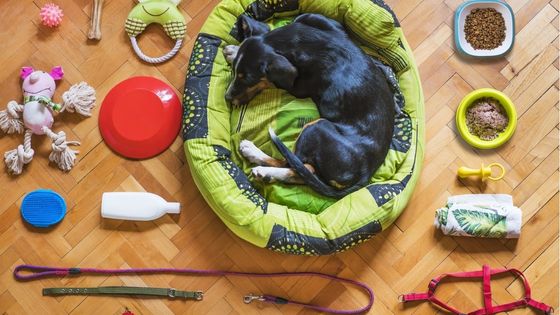Figuring out what supplies you need for a new senior pup is daunting. Just walking through a pet supply store or looking online can be overwhelming.
From water and food bowls to sweaters and beds, we’ll talk about it all right here!
Four Important Things to Mention
- Items are not listed in order of importance
- This list is very thorough with everything I could possibly think of, but you will absolutely not need everything right away and some things you may never need
- Your finances are not my business, but don’t break your budget on your first shopping expedition…as tempting as it will be
- Having all the basics bought and set up before your dog comes home makes everything so much easier, but if you can’t you can’t!
**There are affiliate links in this post, which means if you buy something I may receive a commission. This has no effect on the price for you.**
If you’ve recently welcomed, or are about to welcome a senior dog into your home, I recommend you read this article ⇒ “Bringing Your Senior Rescue Dog Home”
Senior Dog Supplies Checklist
EATING
Food and water bowls
Dog bowls come in plastic, ceramic, silicone, stoneware and stainless steel. A quick note about plastic bowls – when they become scratched bacteria can lodge in the crevices, plus can be easily destroyed if your dog decides to use them as a chew toy.
In my house we use stainless steel or ceramic because they are easy to clean, hard to knock over and won’t become a chew toy. I prefer ceramic for water because we have hard water where we live, and residue builds up around the inside. I do clean them every day but ceramic is a lot easier. You can buy an inexpensive bowl in the dollar store, or splash out for something fancier!
You may want to put more than one water bowl around the house, so your dog is never too far away from a drink.
Please make sure clean fresh water is available at all times!!
Food
Nutrition is a topic that requires more than a few sentences of discussion, and since this post is about supplies I’m going to keep this brief! Dog food comes in several formulations – dry, canned, raw, homemade, dehydrated/freeze dried. It is available in your local dollar store, supermarket, pet supply store, vet’s office, online or from your very own kitchen.
You can buy grain free, some with added supplements, and prescription diets for specific conditions and issues.
A quick tip – as with the ingredient label on human foods, dog food ingredients are listed in order of content. I recommend you choose a good quality food with ingredients you can identify.
Note – when choosing a new food, keep your dog’s health issues in mind. Also, if you’re having trouble deciding on the best diet, do your research. Speak to your vet, a holistic vet or even a dog nutritionist. Ask why they recommend a specific food or don’t recommend it, then see what feels right for you and your dog.
Note – When your dog first comes home, feed him the same food he was eating in the shelter or foster home. Once you’ve decided what you’re going to feed him, gradually switch him over to your new brand…unless you’ll keep him on the same diet! Add a very small amount of new to the old, adding more until he’s completed changed over. The process should take about a week or so, but bear in mind, senior dogs often have more sensitive stomachs than their younger counterparts so don’t rush it.
Treats

It’s quite possible your senior will have new things to learn, or just need a refresher. Either way, treats are a big help!
As with food, they can be bought almost anywhere, and of course the quality will differ. If you’re concerned about what goes into them, there are literally thousands of recipes online, many of them super easy to make. If you prefer the convenience of buying them, again, look for ingredients you can identify. Pieces of apple, raw carrot, green beans and plain boiled chicken can also be used as treats.
It’s also nice for them to have something to chew on to keep them busy. I go to my local dog supply store which has an amazing assortment of tendons, chews, ears etc… The picture above is of Roxy chewing on an ear which she’s loving! I don’t give this to her daily as I don’t want issues with diarrhea or weight gain, but as a treat a couple of times a week it works! I also don’t let her eat the whole thing at once, I take it away half way through and give her the rest another day.
NOTE: Know the condition of your dog’s teeth before you shop. If he’s having problems that require treatment or is missing teeth, opt for something soft.
Spoon for canned food
I like the idea of a spoon specifically set aside for use with dog food. Whether that’s an extra one you have lying around the house, a cheap one you buy in the dollar store, or one made specifically for pet food, the choice is varied…and yours!!
Dog food cover
To keep canned food fresh it can be stored in a zip lock bag, wrapped in saran wrap/foil, or closed with a cover made for just that purpose. The one I linked to, fits 3 different sized cans.
Storage container
If you’ll be feeding dry food, consider buying a food storage container.
There are advantages to a product like this –
- A big bag can be awkward to store
- Not all brands come in a re-sealable bag making it tricky to keep closed and may attract bugs or roaches
- Easier to access the food
Whichever container you buy – a big plastic storage box or one specifically made for dog food, make sure your very enterprising and determined pup can’t pry the lid off. Even if it’s impenetrable, I recommend keeping it out of reach to avoid temptation!!
Don’t forget the scoop!
What I like ⇒ 3 Piece Airtight Storage Containers
WALKING
Collar
Collars come in various sizes, widths, materials and designs, and some have matching leashes and harnesses if you really want to get fashionable!! Keep things simple by starting off with a nylon collar with a buckle and be sure it fits well. Too loose and your dog will easily slip out of it, and too tight is a danger. The trick to knowing if it fits is if you can slip two fingers between the collar and your dog’s neck. Some have the option of the name and phone number embroidered directly onto them, so no ID tag is needed.
If your dog is aggressive due to fear, anxiety or medical issues and you’re having trouble putting a collar on, read this ⇒ “How to Put a Collar on an Aggressive Dog”
ID tag and microchip
Your dog absolutely must be microchipped whether it’s a law in your area or not. If the unthinkable happens and he gets out, you need to have done whatever you can to increase the chances of him coming home. Also, if you will be travelling to other countries together, some are very strict and require it as proof of identification.
The size of a grain of rice, it is inserted between your dog’s shoulder blades. Each one has its’ own identification number that corresponds to your contact details. Should your dog ever be lost, a handheld scanner reads the ID number which, when looked up, reveals contact information. It is very important to always keep your details up to date.
An ID tag is a medallion that hangs from your dog’s collar and contains your contact information. Some people put their dog’s name, address and phone number on it, some put their name and number (not the dog’s name) while others only put phone numbers.
Yes you should have both!!
Leash
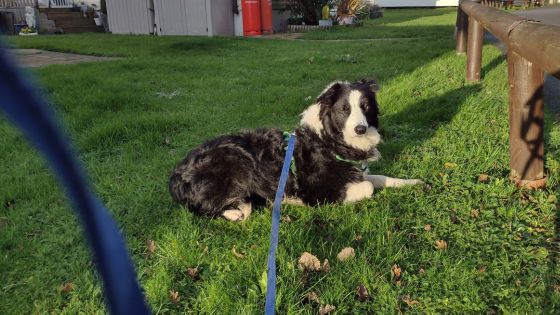
Typically leashes come in lengths of 4’ 5’ or 6′, with flexi leashes measuring a lot longer than that. Nylon leashes are my preferred style in terms of safety and training. I don’t typically recommend a flexi leash, but in some cases they are a good idea. If your senior dog has mobility issues for example, it will give him freedom to sniff around a park, while still being safe. I used one for my blind dog Red and it worked out well. An alternative would be to use what’s called a training leash, and that’s what I use when I take my senior dog to the park. For busier areas I suggest sticking with a standard leash.
Harness
We’re going to talk about two types of harness – one which is used for extra safety, the second for support.
Safety
It is of course your choice whether or not to use a harness, but there are times when I believe they are particularly important.
- When travelling or on a day trip in unfamiliar surroundings
- When walking in large crowds like festivals or fun fairs
- If you will be using a doggy seat belt in the car I prefer to attach the clip to a harness rather than a collar
- If you’ve recently brought your dog home and he’s anxious on walks, or you’re not yet sure how he reacts
I always use a harness no matter what, because I think it’s safer.
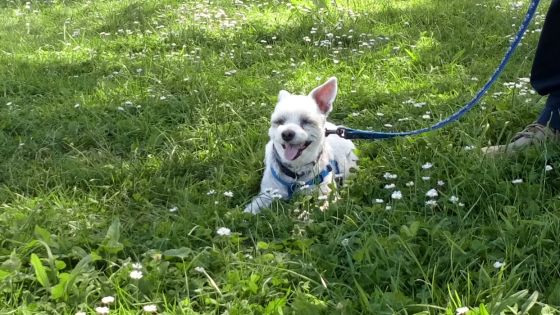
The style harness I love is called the “step in.” We adopt small old dogs that don’t weigh more than 10lbs, so this style works well for us – they’re not bulky, extremely lightweight and super easy to put on and take off.
The picture above is Jack wearing that harness, although unfortunately it’s not as visible as I would like. This shows you what it looks like up close.

Another example of a popular harness style is one my foster dog Roxy wears. There’s a lot more to this one, it has a bit of weight to it and it’s perfect for her. I use a leash with a clip on either end so you can either turn one end into a handle or clip it onto the ring in the front for extra security. I do that when I walk her in the evenings. The foxes are out and she’ll try and chase one if she can. Having one clip attached to the ring at the back and one in the front is safer.
Here’s a link to the Embark harness Roxy is wearing in the picture above.
Support
In terms of support, a very popular harness recommended by many of my FB group members is called the Help ’em Up Harness. They have a fantastic website with all the information you need, so I recommend you check it out.
Poop bags and holder
You could carry bags in your pocket, tons of people do! When I do that they’re constantly falling out, and I find them hard to grab and open. The easiest for me is having a holder attached to every leash so I’m never without bags…unless of course I forget to refill them!!
Poop bags come in basic black, colors, patterns, standard and long size, scented or unscented and compostable.
There are many different styles of holders, some a lot more fiddly than others. Whichever one you choose, make sure the bag inside is easy to access.
FYI – there is a difference in quality when it comes to poop bags, and in this case you do often get what you pay for. The last thing you want is a bag breaking at the worst moment. Been there, done that!
Bag holder I like ⇒ Bag Holder (the carabiner makes it easy to clip on to your leash, simple to refill and bag pulls out quickly).
Poop bags I like ⇒ PET N PET Dog Poop Bags (good value!) or BAGS ON BOARD Poop Bags (I like colors and designs on mine!)
High viz vest/flashing collar/reflective leash
When walking after dark, you want to be as visible as possible to other walkers and cars. High viz vests (for your dog!!), light up collars, flashing discs and reflective or light up leashes are all wonderful safety options. Personally I find the vest makes your dog the most visible, so if you’re walking in a high traffic area or on a dark lane, consider this!
Flashlight
A small flashlight will help you find the poop on your night time walks. I use a flashlight every night when walking my 11 year old foster dog Roxy. I don’t think she sees as well at night as during the day, so l find lighting the path ahead of her, especially because it’s not well lit where I live, helps.
Sweater/Coat/Raincoat

Before I get into this topic, let me just comment on the picture above…sorry for the poor quality!
This was my heart dog Red. I found that sweater in TJ Maxx, and the raincoat on Amazon which I can no longer find. This is an example of how I layered during the colder weather. This raincoat was amazing and kept Red so warm and dry because of the hood, fleece lining (which may have been removable if I remember correctly) and the biggest selling feature, the extra wide piece that covers the stomach. You know how dirty they get when out in the mud, but that doesn’t happen with this coat. It’s also easy to wipe down.
If you live in a cold and/or rainy climate, protective clothing is a good thing to have on hand…and not just for the tiny dogs! Big dogs may need the extra warmth and protection as well! As with everything on this list, there is a huge selection in terms of style, warmth and of course price.
I found the best sweaters in WalMart and on one occasion TJ Maxx. They were inexpensive compared to what you find in a pet supply store, easy to take on and off and they had a good selection.
When choosing a coat think about how easy or difficult it would be to take on and off. Some of my dogs have been fussy, so anything with velcro is what I pick.
When choosing a raincoat think about how easy it will be for them to walk in, because some of them have a lot of material in the front that can be annoying. Whether or not you choose a lined raincoat with depend on the time of year they’ll need it.
When we’ve been in very cold climates, my dogs wore a sweater and a coat over it for added warmth.
NOTE: Some coats have a removable lining, making it suitable for warmer and cooler weather.
Paw protection
Salt and snow can be really tough on a dog’s paws…not to mention painful. Booties are a great option, except many dogs are not willing to wear them. Paw wax is a good alternative for winter walks.
Try this ⇒ Bark Brite Dog Boots – there are many different brands, all pretty much the same style
Try this ⇒ Musher’s Secret Paw Protection – this is the most well known brand, but I just went into my local pet supply store and bought the wax they had. It did a good job of protecting my dog Red’s paws from the salt.
Dog stroller
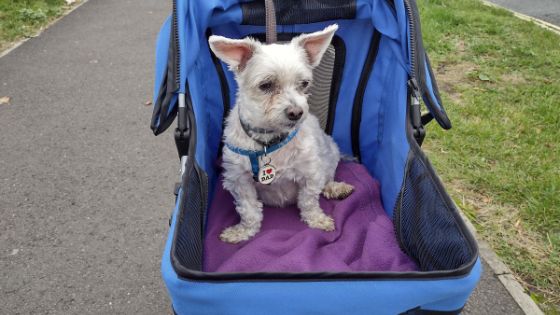
In my opinion, this is the best dog product ever invented and a must have for every senior dog parent. No matter how small a dog is, they get heavy after carrying them a few minutes, which is why this is the perfect solution. Let your dog walk as long as he can, when he needs a break put him in the stroller. No more being left home alone while you’re out having fun. We take our stroller on buses, trains and ferries, and use it for long walks. Red loved hers, and Jack loved his.
Strollers come in various sizes, the one above is small because my dog only weighs 10 lbs. If your dog is too big for even the biggest stroller, check out the selection of wagons on places like Amazon for example.
SLEEPING
Bed
Flat, high sides, round, square, rectangle, orthopedic and more, beds come in so many styles, sizes and fabrics how do you even begin? Finding the bed your pup will love can be a case of trial and error, so I recommend starting with a cosy fabric, support on the bottom, three raised sides to lean against and a lower front for ease of access. This style is called a bolster bed.
We’ve had many styles of beds in this house, and the most popular with my dog Red was a human comforter! I put a cover on it, folded it for support, but it was flexible so she could re-arrange it as she wanted. I also had a fleece blanket on it in the winter for extra warmth. Jack switches between his donut bed and a fleece blanket on top of a pillow. Go figure!
What Jack likes ⇒ Calming Cuddler Bolster Bed (this is the style Jack loves when he goes to visit his best friend Tyrion).
What about this? ⇒ Happy Care Orthopedic Bolster Bed
Blankets
If you have dogs then you need blankets. Whether it’s to throw on top of her beds for extra warmth and comfort, to protect your couch when you’re relaxing together, or to make her crate or carrier cosier, you’ll always have a need for them. Fleece are my favorite.
TRAINING
Crate
A crate is an option to consider, but it doesn’t mean you have to close the door when he’s in it. It’s…
- A cosy den when your pup needs alone time
- Safety during car travel
- A place to rest and recover from illness or surgery
- Home away from home when visiting friends or staying in a hotel
Crates are available in different sizes, styles and price points you’ll easily find something to suit your needs.
My advice – the crate should be big enough for your pup to stand up, turn around and lie down comfortably, but not too big that he has enough room to pee or poop in a corner.
What I like ⇒ Frisco Fold & Carry Double Door Collapsible Crate (a different brand to the one we have, but same style. We used it for months after Jack had spinal surgery, and it was the perfect way to keep him on bed rest!)
Not all senior dogs will be happy in a crate with the door closed, and if it’s their first time you’ll need to do some training to get them used to it. I don’t recommend you close the door of a crate if your dog is anxious or has dementia as they could panic.
Crate pillow or pad
Your pup will need a pillow or pad to lie on while in the crate, and they’re easy to find online or any pet supply store.
Training classes
If your dog needs a refresher or has some basic cues to learn, there are tons of training videos online. Prefer working one on one with a trainer? Do a search for someone in your area and have a chat with them before you commit.
Treat pouch
Slide the pouch onto your belt or clip it on a pocket, waist band or purse to keep treats close at hand and easily accessible. Why is that necessary? When you’re training it’s important to reward your dog immediately, so he will understand the connection between the reward and the behaviour.
Even if your dog is already trained, if you have a new rescue dog keeping treats with you on your walks is a great way to distraction him and keep him focused on you.
Puppy pads
Disposable or washable, puppy pads are super absorbent so will protect your flooring from accidents. They’re handy…
- For use in the bottom of a carrier when travelling
- When recovering from illness or injury and confined to cage rest
- Peeing often due to medication or medical condition
I bought the least expensive disposable ones I could find in a local store, and they were perfect. I used them for months when my dog Red developed dementia and would pee wherever she was. My entire floor was covered which wasn’t the most attractive look, but it prevented pee stains on my carpet.
CONTAINMENT and SAFETY
If your dog is having accidents on the floor, or wandering around confused, finding ways to keep him safe are a priority.
Exercise pen
A pen is made up of wire panels that fold, and keeps your dog in a specific area. You can extend it fully or not, depending on the size of your space. You can attach a couple together to create a larger area.
Baby gates
Baby gates are pretty much a “must have” item, for the top and bottom of stairs.
MENTAL STIMULATION/FUN AND GAMES
Toys
The range of toys available is mind boggling!! Having said that it’s a good thing, because you can find a toy for so many different purposes.
- Treat dispensing and puzzle toys can occupy your dog and get his brain stimulated
- Lickimats can keep him occupied longer
- Chew toys satisfy the need to gnaw so he won’t use your favourite pair of shoes!
- Balls and flying discs are great for chasing
- Rope toys help with dental care
- Plush toys are fun to carry around in their mouth
A couple of words of advice –
Don’t give your pup too many toys to play with at once, it will overwhelm him. One or two, then rotate to keep him interested.
Available almost anywhere, quality varies so only buy strong, durable and well- made toys, with no small parts that can be chewed off and swallowed.
A must have item ⇒ Classic Kong
HELPFUL TIP: Feed your dog some of his meals (or all!) in a puzzle toy or Kong. It will make meal time last longer and will be much more enjoyable!
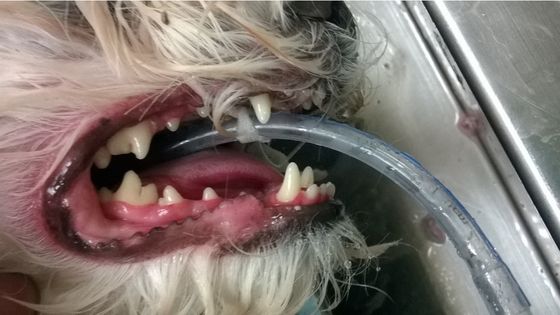
DENTAL CARE
Just like we brush every day to keep our teeth and gums healthy, we should be doing the same for our dogs. Poor oral hygiene can cause pain we don’t even know they’re feeling, as well as serious health issues down the road. Fortunately there are lots of products that can help.
One note of caution – be sure Xylitol is not an ingredient in anything your dog ingests as it is dangerous!
Toothbrush
A doggy toothbrush looks like a human toothbrush, and for convenience some come with a small brush on one end, a larger one at the other. Other styles include ones that fit over your finger, silicone and electric. None of the seniors I adopted ever had their teeth brushed, so a finger toothbrush was the only thing I could use.
Toothpaste
Gels or pastes, wipes or sprays, toothpaste comes in various flavours some more natural than others.
Water additive
Like a mouthwash, it is added to your dog’s drinking water to help clean teeth, freshen breath and keep plaque at bay.
Dental chews/bones/sticks/toys
Giving your pup something to chew on can help keep teeth clean, and of course keep him occupied and entertained. Please, never leave your dog unattended when he’s chewing on a stick or bone. A word of caution here…a large majority of senior dogs who are rescued have bad teeth, so these may be too tough for your dog, at least until after dental issues are sorted.
KEEPING COOL
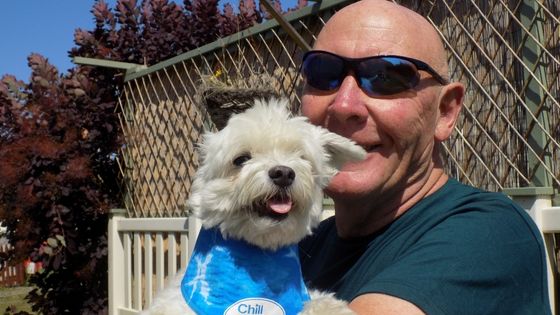
If your dog has a hard time in the heat like mine does, a dog cooling mat, bandana or vest are a must have. Jack has a bandana (picture above) which helps.
OTHER HEALTH SUPPLIES
Flea, tick and heartworm prevention
Have a conversation with your vet about the options you have. What you choose will depend on whether or not having natural ingredients are important. My dog Jack is allergic to every treatment I tried, until I found the Seresto collar. I change it every 6-7 months and it’s kept the fleas away.
Supplements
The supplements you choose will depend on what’s going on with your dog. Here are a few examples of what you may need:
Joint issues
Turmeric Golden Paste (you can find the recipe online or in the Turmeric User Group FB group)
Glucosamine and Chondroitin
New Zealand Green Lipped Mussels (Super Snouts Joint Powder is a popular product)
Anxiety
For a list of natural options, read this ⇒ “22 Natural Ways to Calm Your Anxious Dog“
GROOMING SUPPLIES
This is a detailed list of everything one could need to groom a dog. Even if you decide to have a groomer take care of everything, there are still a few things that will be handy to have at home.
Read this ⇒ Should Old Dogs Go to the Groomer?
Doggy wipes
Perfect for cleaning muddy paws, keep them by the front and back doors, in the car, your purse…
Towels
You can never have enough towels on hand when you have a dog. Have a couple in the car, and near the door on a rainy day.
Brush/comb
Hard bristles or soft, wide tooth or not, or one made of rubber, a daily brush keeps your dog’s coat clean and untangled, feels good (for your dog!) and is a wonderful bonding opportunity.
De-shedding tool
Brushes will get rid of loose hair, but nothing like a de-shedding tool…at least not in my experience.
Blow dryer
If you’ll be using a blow dryer, put it on the lowest setting and don’t blow it in his face. Sorry if this is obvious!! It’s much too loud for Jack, and I would say many senior dogs, so I dry him off using towels. It’s a wonderful experience for him, he loves it and happily sits for as long as it takes. I enjoy it as well.
Ear cleaning solution
Ear cleaning is important to reduce the chance of infection and prevent wax build up. It’s best to ask your vet’s advice about frequency and have him show you how to do it safely.
Nail clippers
Some senior dog parents have an easy time trimming nails, some don’t, and others don’t want to do it at all (like me!). Your vet, vet nurse or groomer can show you how if you want to give it a try.
Styptic powder
If you’ll be using nail clippers you’re going to need styptic powder.
There is something called the “quick” inside your dog’s nails, which is basically a tiny blood vessel. It is often clipped when an inexperienced pup parent cuts their pets’ nails. Actually it happens with experienced groomers too! This powder is a clotting agent and antiseptic that pretty much stops the bleeding immediately.
Scissors/clippers
If you’ll be grooming your dog on your own, scissors or clippers are a necessity. There are pet clippers but regular men’s clippers will do the trick. It’s not easy to clip a dog, especially around the face so think whether this is something you want to try.
Shampoo and conditioner
Even if you will be completely relying on a groomer to keep your dog clean and beautified, there will be times when you’ll need to give your dog a bath. Rolling in mud or something unidentifiable is a very common reason!!
CAREGIVERS
What I’m about to say applies to all caregivers, so it’s easier if I say it once.
Some are great, some should have their licenses revoked. I don’t say this to scare you, I say this because I don’t want you to think that every vet, groomer, trainer or pet sitter is amazing…because they aren’t! Having said that, with a bit of research you can find the incredible souls who will help you take great care of your sweetie.
Vet
Not all vets are created equal, so it’s important you like and trust the one that will help you care for your dog. We know our animals best, so if we feel there is something wrong we are usually right. Don’t be afraid to ask questions, and if you have concerns about the treatment you’re receiving, consider changing vets. Sadly not all see the value in an old dog, and many will reply to your concern with “it’s just old age.” Sorry, old is not a diagnosis.
Pet sitter/dog walker/doggy day care
Start your search with a visit to your vet’s office. There is often at least one staff member who does pet sitting on the side, or may know someone. Many pet carers leave cards there and in the local pet supply stores. Ask everyone you know, make some calls and set up appointments to meet them. What impression did you get? How did they interact with your dog? How many senior dogs have they cared for? Are they comfortable giving medication such as pills, drops or injections?
It can take a long time to find someone you trust, so even if you don’t need one now, plan for the future. It’s always best to have at least a couple of names on your list. You never know!
Groomer
The best way to find a groomer is by asking dog parents who they use. Again, check with the vet staff or do a search for groomers in your area. However you find the names for your list, I recommend calling and having a chat about the process, how long it takes, how much it costs and if you meet in person it’s a chance to check out the cleanliness of the facilities.
Be sure to mention you have an older dog, and any medical issues he or she has. When I moved to Florida I found it impossible to find a groomer for my old blind dog anywhere near me.
Trainer
You don’t see many older dogs going to training classes, but that doesn’t mean they couldn’t benefit from a refresher. or learning something new. It’s good for the brain!
WiFi camera/nanny cam
It can be stressful leaving your pup alone, or with a new pet sitter for the first time. A nanny cam is a great way to keep your eye on things, see how he behaves when alone, or make sure the sitter is doing a good job. I don’t like “spying” on people but sadly, enough horror stories means you need to be sure.
Pet insurance
In my experience most people take out pet insurance, but there are some who prefer to set aside money on a regular basis for vet bills. As with any type of insurance, coverage and costs vary widely so ask other pup parents what they do. Reception staff at your vet’s office can be a good source of info. While it’s true they may have an arrangement to promote one particular company, it’s the staff who put claims through so they have a good idea which companies pay easily, offer better coverage…
TRAVEL
Pet carrier/crate/travel bag
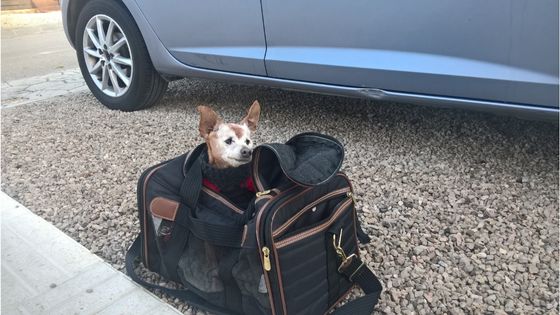
A carrier will be necessary, and useful, for so many scenarios including –
- Safety in a car
- When travelling by train
- Flying (whether in the cabin with you or cargo)
Train companies and airlines have specific requirements so call before you buy.
What I use ⇒ Sherpa Original Deluxe Airline Approved Pet Carrier
Seat belt
In some places it is a law for your pup to be secured in a vehicle, but it makes good safety sense so you should do it anyway. A seat belt has the buckle that snaps into that piece in the car (don’t know what it’s called!!), and the other end has a clasp to hook onto your dog’s collar or harness.
What I use ⇒ Adjustable Seatbelt (I have a different brand, same seatbelt, works very well)
Car booster seat
Another way to secure your dog so he can’t move around the car, but can still look out the window.
How cute is this! ⇒ K&H Bucket Booster Seat
Collapsible/foldable/travel food and water bowls
Whether you’re out on a day trip or extended holiday, collapsible/foldable food and water bowls are easy to transport, don’t take up much space and some even fit in your pocket for easy access!!
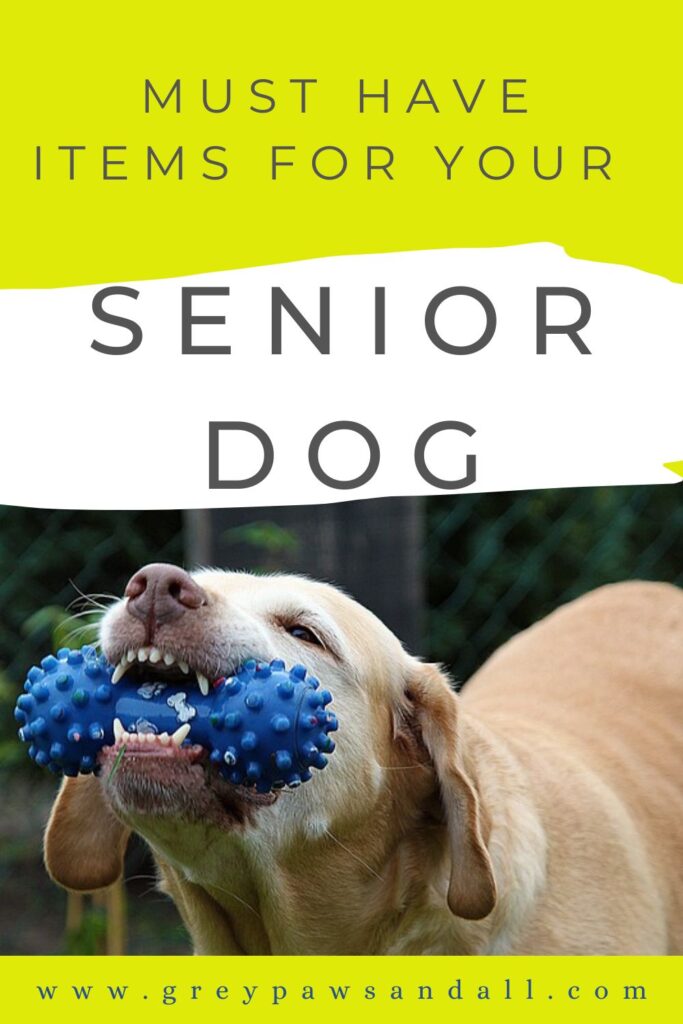
Car seat cover
Protect your car seats from muddy wet paws and dog hair with a car seat cover. Towels, blankets and sheets can help to a certain extent but they are not waterproof and easily move, so they aren’t ideal. One specifically made for that purpose will offer the best degree of protection.
Dog barrier
A dog barrier will keep your dog securely in the back of the car, preventing him from running around and causing an accident.
Car emergency kit for pets and people
Be prepared in case of trouble on a car trip with a well-stocked emergency kit. Buy a ready made one and add to it (if necessary) or put together your own.
What I like ⇒ Kurgo Pet First Aid Kit
What I like ⇒ First Aid Kit for Humans
EMERGENCY
Keep drugs, cleaning products, wires, rubber bands, plants, small toys and any other potential hazards out of your dog’s reach.
Poison control hotline/helpline
Should you have a concern about something your dog might have ingested, don’t wait until you see symptoms, call the poison control hotline immediately. Program the number into your phone, keep it by your landline and anywhere else for easy access. Be prepared to rush him to the vet if necessary.
ASPCA Animal Poison Control Center Phone Number: (888) 426-4435
Pet Poison Helpline: (855) 764-7661
24 hour emergency hospital
Why do things seem to happen after the vet closes for the day? Having the address and phone number of 24 hour emergency hospitals in your area is a must. Keep the details in your phone and in an easily accessible place in your home.
Dog first aid kit
Keep one wherever you’re going to be with your dog – home, car, motor home, cottage… Ready made kits are available for purchase or check out the items they include and make your own!!
CLEANING SUPPLIES
Paper towels
Paper towels are great for cleaning up accidents among other things. I don’t blame you for looking for the cheapest ones around, but often they end up costing the most because you need so many more to do the job.
Carpet cleaner
Accidents happen and muddy paws happen, so a good carpet cleaner is a must. You may need to try a few before you find the one that works best for you. There are lots of natural options on the market that are safer for your pets, or find homemade recipes online.
Carpet freshener
With people, kids and now a dog running around, carpet freshener is a great product to have on hand to “freshen” things up.
Steam cleaner
Sometimes a carpet cleaner isn’t enough, or every once in a while you want to give your carpet a really deep clean. A steam cleaner is the way to go. I have one and it makes a huge difference.
Flea killer
I know it’s not technically a cleaning product, but sometimes you’ll have a dog that is resistant to some flea treatments. If that happens and you find yourself with a flea situation, you’ll need it.
I hope you’ve found this list helpful, and not too overwhelming. Like I mentioned at the beginning, I wanted to create as thorough a list as I could, but not every item will be needed…and certainly not right away.
If you’re looking for a community of senior dog parents, a place where you can find helpful tips, support and people who “get it” please join my FB group Senior Dog Care Club
I help senior dog parents struggling with anticipatory grief and quality of life issues by offering practical tips, advice and one on one support. I am also a Pet Loss Bereavement Specialist, helping you navigate through your pet loss journey.
Visit my services page to book a FREE 20 minute discovery call, or email me (Hindy) at hindy.greypawsandall@gmail.com if you have any questions.
I’ve been rescuing and caring for senior dogs since 2009. From vision and hearing loss to obesity, dementia, kidney disease, liver issues, cardiac problems, Cushing’s, mobility challenges and more, you could say I’ve dealt with and learned a lot! In addition to my hands on experience, I’ve taken many courses and earned several qualifications to keep learning how to help senior dogs and they include: Senior Dog Enrichment, Understanding Canine Anxiety, Care of the Senior Pet and I’m a Certified Pet Loss Specialist.

